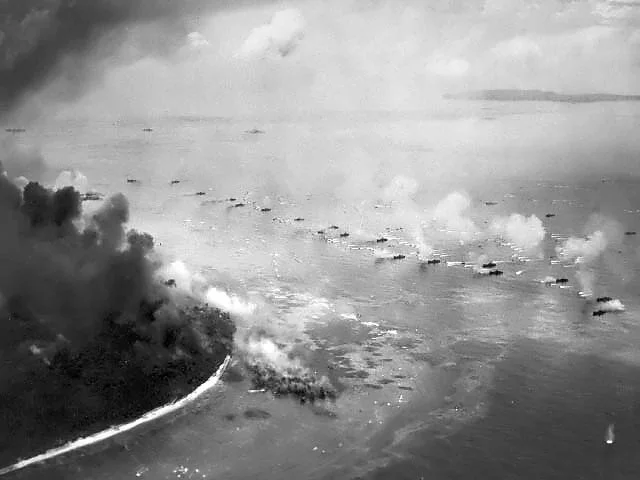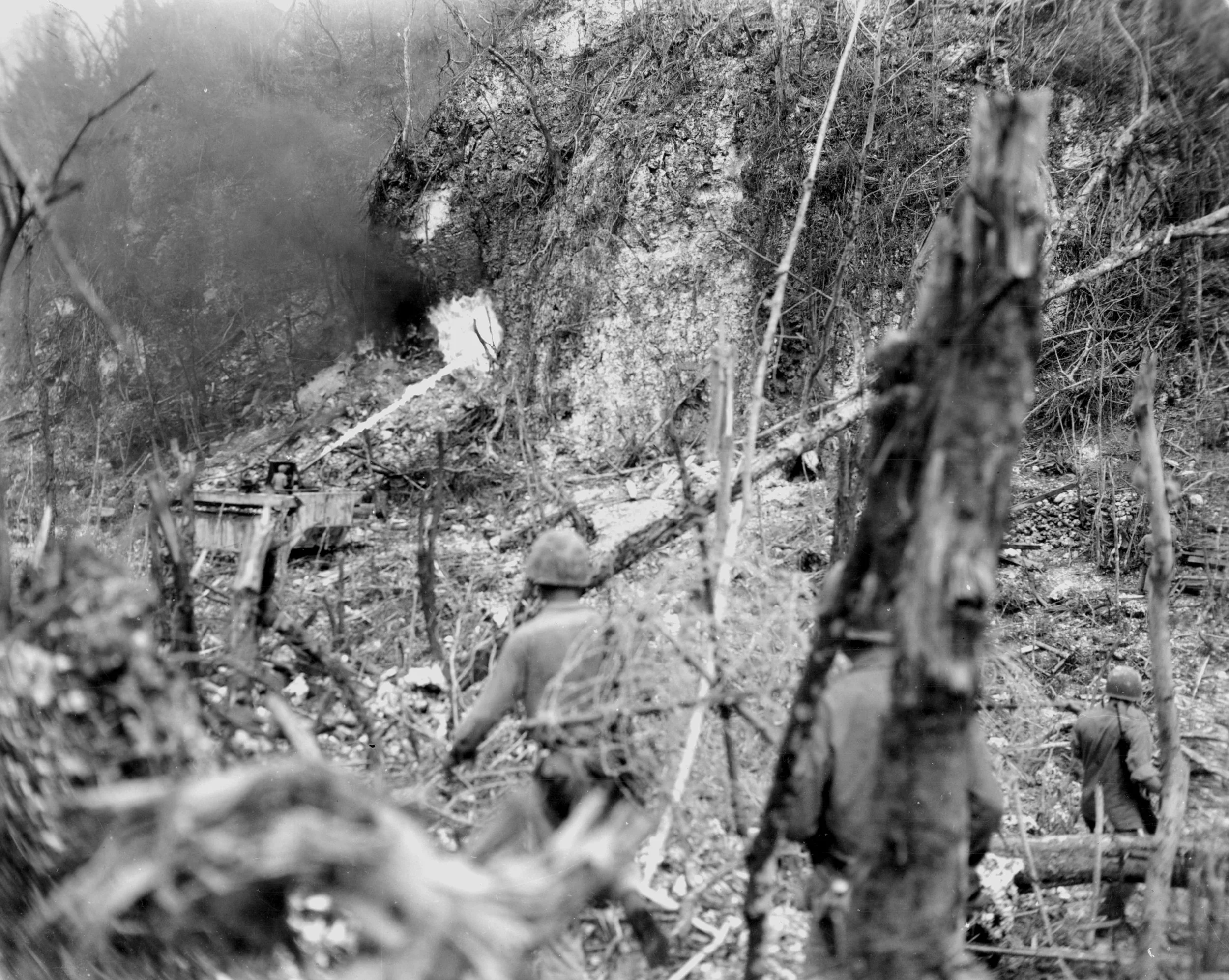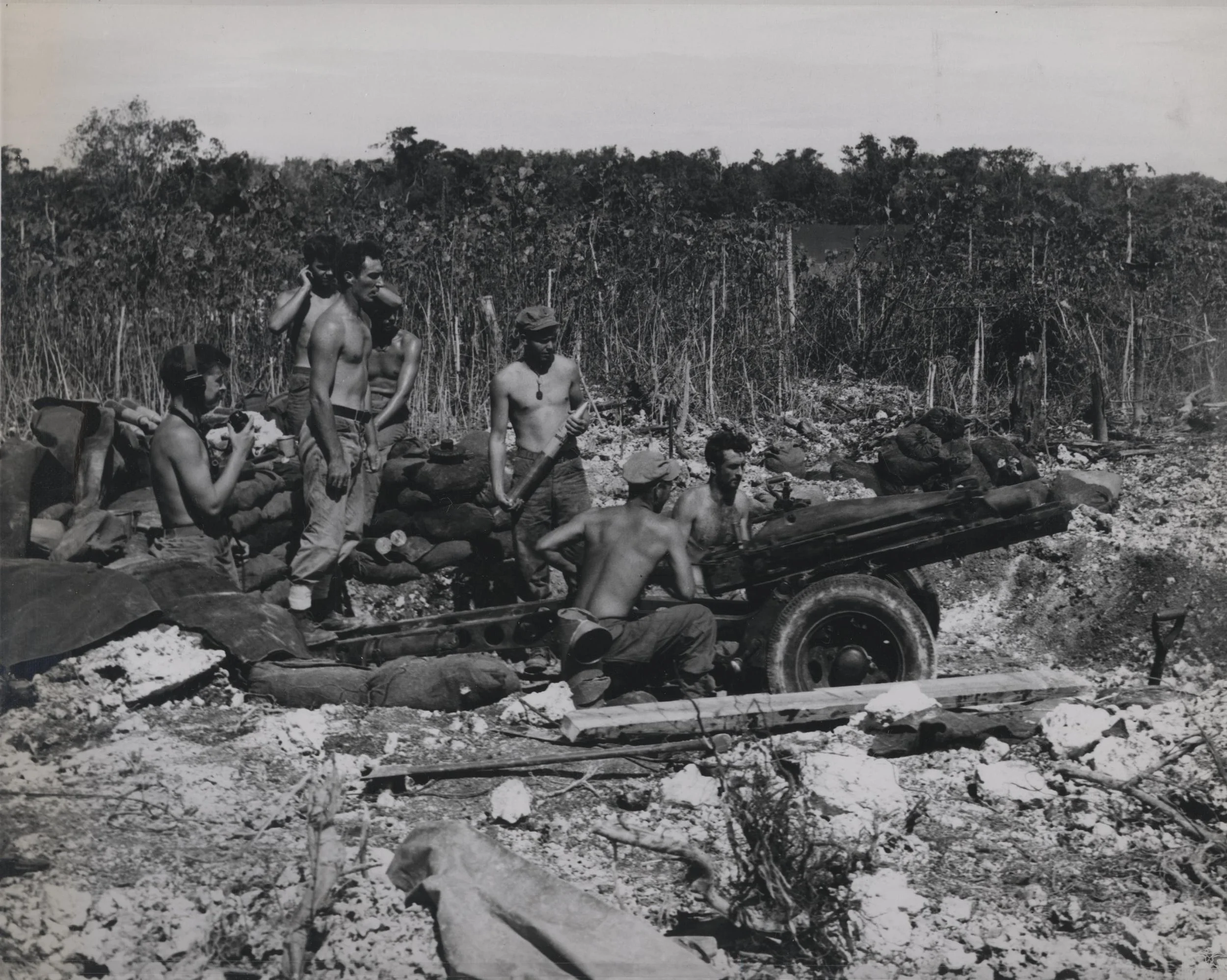The Battle of Peleliu
Chapter 38
“When the tide went out that night, you could have walked 300 yards across the beach on the bodies of dead Marines”
15 September - 27 November, 1944
The first wave of USMC landing craft approach Peleliu, the entire shorline covered in smoke from the preliminary bombardment
Following the capture of the Marianas, the Americans found themselves needing to choose their strategy as the War in the Pacific entered a new phase subsequent to the penetration of the Japanese Empire’s pre-war perimeter. At a high level conference in Hawaii, President Roosevelt and his Chief of Staff Admiral William D. Leahy met with US Navy commander Admiral Chester Nimitz (commander of the Central Pacific Area) and US Army commander General Douglas MacArthur (commander of the South Pacific Area). Just as was occurring in Europe, the two commanders had competing strategies for the future direction of the war. MacArthur’s plan was to liberate the Philippines, using them as a step toward the Japanese island of Okinawa and from there to the Home Islands. Nimitz, on the other hand, favored bypassing the Philippines in favor of Formosa, before seizing Okinawa and the invasion of Japan proper.
Japanese officers inspect a beach on Peleliu before the battle
In the end, the arguments of MacArthur, including the fact that the Philippines were US territory under occupation, led Roosevelt and Leahy to approve his plan. Thus, Nimitz was ordered to support the operation with his fleet, and his Marine forces were to secure the islands of the Palau chain to protect the flank of MacArthur’s forces. The plan, designated Operation Stalemate II, was for an invasion of two islands, Peleliu and Anguar, to dislodge the Japanese garrisons there and establish air bases from which to support the campaign in the Philippines.
A Japanese bunker on Peleliu
The Japanese, for their part, whilst still refusing to acknowledge that the war was lost were beginning to shift their strategy from offensive to defensive, with an aim at bleeding the Americans as they advanced toward the Home Islands. Unlike previous failed island battles where the defenders had attempted to meet the enemy head on at the landing beaches, this time plans were in place for a defence in depth, intended to draw out the battle as long as possible. Over 10,000 (over half of which were combat personnel) Japanese were on the island, including crack IJA troops transferred from the Chinese front to bolster its defense. A small armored detachment was also stationed on the island, along with aviation units stationed on the large airbase on the islands south side.
Marines take cover behind a knocked out LVT
The Americans set sail from the Solomons at the start of September, meeting up with a large Navy task force assigned to support their landings. Five battleships and seven cruisers, along with carrier based aircraft, bombarded the island for three days prior to the landings, although the well dug in Japanese, sheltering in bunkers hewn from the caves that honeycombed the island, suffered little lasting damage. The plan for the 1st Marine Division was essentially the same as prior landings, landing along beaches close to the Japanese airbase in order to secure it quickly, before pushing into the jungle interior of the island.
A Marine with a head wound is brought to an aid station in the rear by Navy Corpsmen
As the Marine LVTs crawled across the coral reef some 700 yards before the beach itself, the Japanese opened fire from their bunkers on the promontories overlooking both flanks with artillery and AA guns. As LVTs and other craft were destroyed around them, the first elements of the Marines reached the sandy shores and were immediately brought under heavy fire from a Japanese strongpoint that came to be known as “The Point”. Heavy casualties were taken and communications equipment was badly damaged on the approach, leaving the Americans with difficulty in arranging for supporting fire.
A wrecked Japanese tank on Peleliu, a G4M “Betty” bomber in the background having met a similar fate
Elsewhere on the beach, the Marines had managed to press inland via coconut groves and approached the airfield, eliciting a Japanese counterattack with tanks supporting their infantry. The battle took place here along the open runways of the base, with the conditions favorable to American air support, resulting in its failure. As night fell on 15 September, the Americans had secured a two mile beachhead, but little else. it was becoming quite apparent that the three day timetable for the capture of Peleliu would not be met.
A Marine prepares to fire an M1 Bazooka rocket launcher at a Japanese position
The airfield was captured on the second day of the battle, with the Marines sustaining high casualties from Japanese heavy artillery batteries in the high ground overlooking the base, and reached the eastern shoreline. Heavy resistance by Japanese forces entrenched but now cut off along the southern tip of the island, and fighting continued on The Point as well. This position was finally secured by Marines of the 3rd Battalion by the afternoon, with only 18 left standing after counterattacks by the Japanese were repelled, sometimes with hand to hand combat.
A Marine LVT fires a flamethrower at a Japanese position, while Marine infantry move up
With the airfield secured, the Marines prepared to push into the center of the island, dominated by a the peak known as the Umerbrogol, nicknamed “Bloody Nose Ridge” by the Marines. Having sustained heavy casualties, the Marines were reinforced for this next phase of the operation by US Army troops of the 81st Infantry Division, despite the reluctance of Marine leadership to accept the assistance of the other branch. The Japanese defenses formed a warren of interconnecting caves throughout the area, and clearing them became a long and costly slog for the Americans. Flamethrower equipped tanks, nicknamed “Zippos” were of some help, but in many cases could not be brought up to the higher elevation positions, requiring traditional infantry assaults to clear them out. Everywhere the Japanese held to the last, inflicting terrible casualties in ambush style attacks. During capture of Hill 100 the 1st Marine Battalion was reduced to 30% strength, with that position merely followed by yet another strongpoint.
Two Marines share a smoke break during a lull in the fighting
All while this was occurring, the Americans were suffering due to the extreme tropical heat, with temperatures approaching 120 degrees Fahrenheit. Dehydration became a serious problem, with fresh water difficult to transport to the men on the line. The problem was further exacerbated by an attempt to transport water inside of recycled fuel drums, rendering the water unpotable and sickening those who attempted to use it.
Fuel drums full of water are unloaded on the beach of Peleliu
Marine air support was also brought in as soon as the airfield was secure, with the first Corsairs of VMF114 taking off under Japanese fire to drop their payload of bombs or napalm before returning to rearm and repeat, in a matter of mere minutes. By the end of September, the Japanese positons at the Umerbrogol had been surrounded as the Americans took the entire shoreline of Peleliu after landing US Army troops in the north, but those defenders trapped inside the pocket remained entrenched and committed to the fight. Using tactics described as “Blowtorch and Corkscrew” (flamethrowers followed by demolition charges), the Americans slowly reduced one strongpoint after another through the month of October.
A Marine pack howitzer in action
The commander of the Japanese defenders, Colonel Kunio Nakagawa, was forced to concede that the end had come by late November. Dispatching a final report to his superiors, he destroyed his regimental colors and committed seppuku on 24 November. His last orders to what remained of his forces were to continue resistance until the bitter end in what pockets were left to them and by infiltrating the American lines. Major organized resistance came to an end three days later, on 27 November, although the last isolated holdouts would not surrender for another three years.
A USMC Corsair drops napalm on japanese positons atop Bloody Nose Ridge
The battle for Peleliu would be remembered as one of the most difficult battles of the entire war for the Americans, and consumed over a third of the 1st Marine Division, with the highest casualty rate of any battle in the Pacific Theater. Over 1,500 Americans were killed, and almost 7,000 wounded, while the Japanese garrison was annihilated almost to the last man. Argument continues to this day over the real necessity of the battle, as Peleliu was never put to heavy use to support the Philippine campaign or the future drive on Japan. Occurring at the same time as the return to the Philippines as well as the failure of Market Garden in Europe, the battle was also glossed over in the press at home, remaining a bitter memory for those who fought there.
The famous painting “The Two-Thousand Yard Stare” by Thomas Lea, depicting a Marine on Peleliu
The Commanders




















